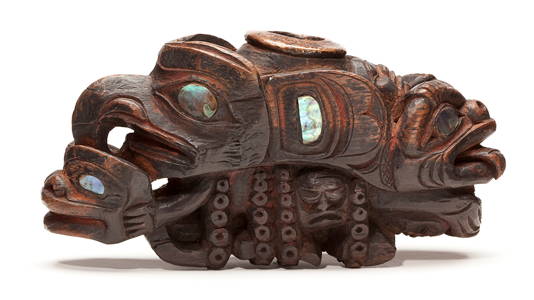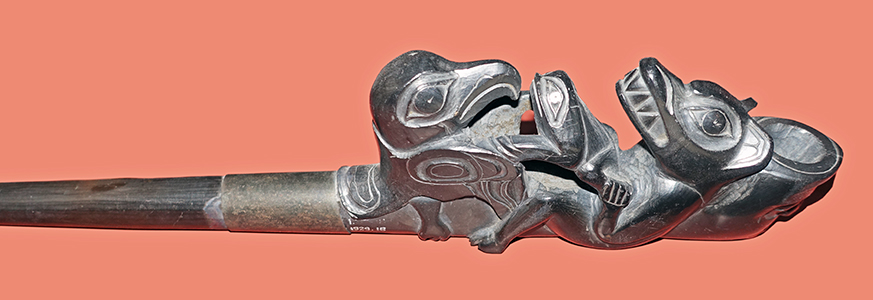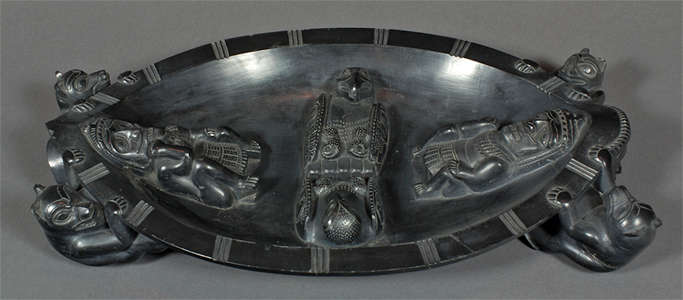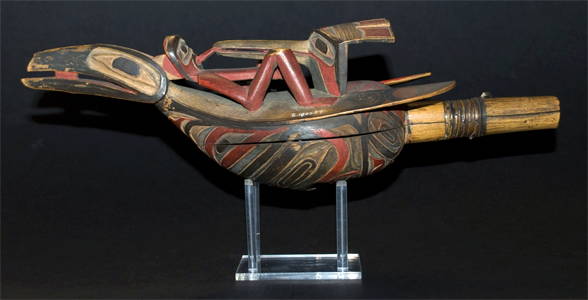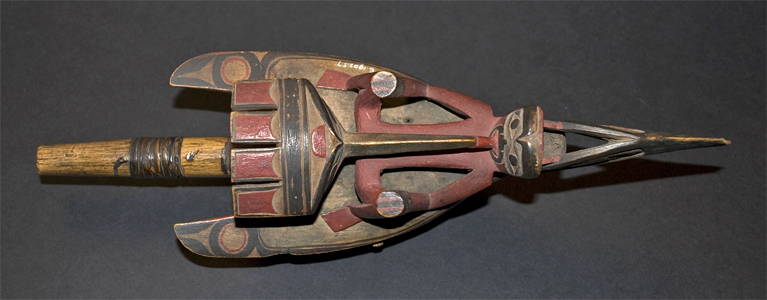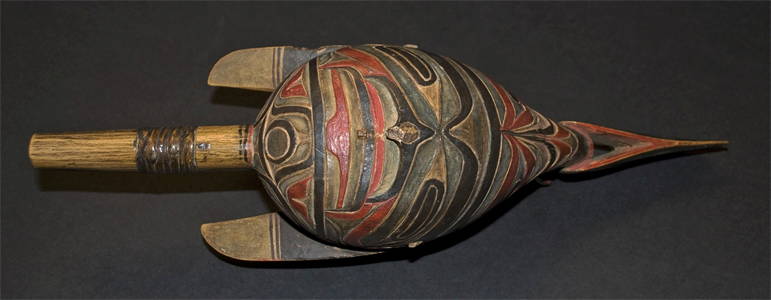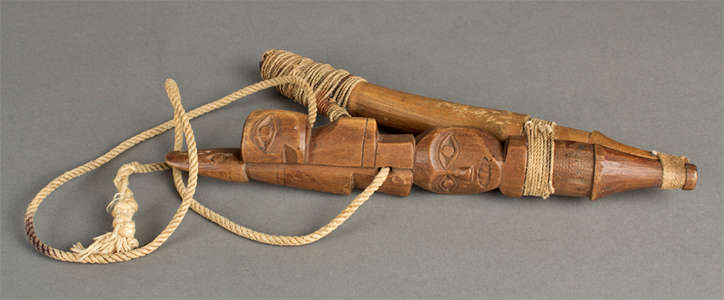Back to Don's Maps
 Back to Archaeological Sites
Back to Archaeological Sites
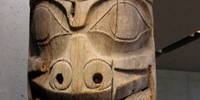 Back to Pacific NW Coast index
Back to Pacific NW Coast index
Artefacts of the First Nations of the Pacific Northwest
Artifacts other than ceremonial poles, clothing and masks
The Indigenous peoples of the Pacific Northwest Coast are the pre-Columbian inhabitants of the Pacific Northwest Coast, their descendants, and many ethnic groups who identify with those historical peoples. They are now situated within the Canadian Province of British Columbia and the U.S. states of Alaska, Washington and Oregon.
The indigenous peoples of the Pacific Northwest Coast at one time had the most densely populated areas of indigenous people. The land and waters provided rich natural resources through cedar and salmon, and highly structured cultures developed from relatively dense populations. Within the Pacific Northwest, many different nations developed, each with their own distinct history, culture, and society. Some cultures in this region were very similar and share certain elements, such as the importance of salmon to their cultures, while others differed. Prior to contact, and for a brief time after colonisation, some of these groups regularly conducted war against each other through raids and attacks. Through warfare they gathered captives for slavery.
The creation of beautiful and practical objects (for all tribal communities) served as a means of transmitting stories, history, wisdom and property from generation to generation. Art provided Indigenous people with a tie to the land by depicting their histories on totem poles the Big (Plank) Houses of the Pacific Northwest coast – the symbols depicted were a constant reminder of their birth places, lineages and nations. Due to the abundance of natural resources and the affluence of most Northwest tribes, there was plenty of leisure time to create art. Many works of art served practical purposes, such as clothing, tools, weapons of war and hunting, transportation, cooking, and shelter; but others were purely aesthetic.
Spiritualism, the supernatural and the importance of the environment played integral roles in day-to-day life. Therefore, it was not unusual for their worldly goods to be adorned with symbols, crests and totems that represented some important figure(s) from both the seen and unseen worlds. Often different northern tribes would adorn their possessions with symbols that represented a tribe as a collective (i.e., clan); this would often be a signal of differentiation among tribal groups. Such symbols could be compared to a coat of arms, or running up the flag of a country on a sailing ship, as it approached a harbour.
After the arrival of the Europeans, Indigenous artefacts suddenly became a hot commodity to be collected and placed in museums and other institutions, and many tribal groups were looted of their precious items by over-zealous collectors. It is only in recent years that many Native organisations have been calling for a return of some of their sacred items, such as masks and regalia, that symbolise their cultural heritage.
Text above: Wikipedia

Tlingit Ivory Amulet
Carved and Pierced Whale Tooth with Abalone Shell Inlay
ca. 1840-1860
85 mm long
Provenance: Skinner’s March 25, 2000; Ron Nasser, Inc.
Tlingit shamans' amulets often include images of spirit-travel, the shaman's journey into other worlds in order to gain information crucial to their practice. In this warmly coloured example, the shaman image reclines with clasped hands at his middle, on the backs of two (or an ambiguous combination of two) spirit images. On the right end, a head that may represent a salmon, or more likely a humpback whale, includes a protruding snout. Behind and below this head, elongated pectoral fins sweep back along the sides of the amulet.
The narrow snout and the length of these fins seem to replicate the proportions of a humpback whale, a crest of the Gaanaxteidi clan of the northern Tlingit. The head of the shaman is positioned in a way that allows it to double as the blowhole or breathing spout of the whale. Within the sculpture, along its central axis, the bare vertebrae of the whale are carved. Exposed vertebrae are a common shamanic symbol for spirit, rather than physical form.
At the 'tail' end of the line of vertebrae, a bird's head is carved. The true meaning or representation of this head is somewhat obscure, but it may depict a raven. This detailed and compact sculpture encapsulates the concept of a shaman traveling in the spirit realm, guided and accompanied by his whale and possibly raven spirit helpers, en route to the spiritual knowledge that will allow him to restore the health of a patient, know the future, or ascertain the identity of a witch.
Photo and text: http://www.northwestcoastindian.com/ivory4.html
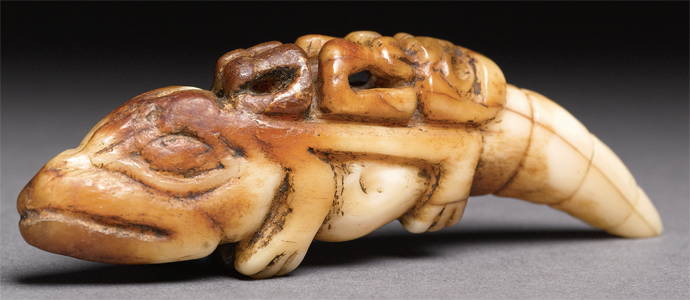
Tlingit amulet
On sale at Sothebey's from a private Canadian collection.
Carved in the form of a land otter, with a stylised human figure reclining on its back, probably a shaman, limbs hugging the body, with thick lips and arching brows; deep aged patina overall.
length 2 7/8 in, 73 mm.
Photo and text: http://www.sothebys.com/
 Skagit atlatl (spear thrower)
Skagit atlatl (spear thrower)
Swinomish, Puget Sound Salish, Washington State
1 700 ± 100 BP (AMS date) Yew wood
394 x 95 x 50 mm A7021
Museum purchase (H.R. MacMillan funds)
The Skagit atlatl, an ancient spear-throwing device, provides an intriguing glimpse into the artistic power, spiritual beliefs and technology of Salish people living in the early years of the first millennium. This weapon survived for 1 700 years, buried in alluvium in the Skagit estuary, until dredged from these silts by a seine fisher's net in 1939 in the Lower Skagit between Townhead Island and Bald Head Island. Although some archaeologists initially considered the atlatl apart from local art traditions, recent analysis reveals its affinity with decorated objects created during the same time period and its strong connections to historic and contemporary Salish art.
The atlatl's most prominent feature is the magnificent feather-crested lightning snake associated with sea mammal hunting in Salish cosmology. Testing on a replica made by Lyle Wilson for the museum's 'Written in the Earth' exhibition showed that the original would have been a very effective hunting tool. (AMS)
This intricately carved fragment of a wooden spear thrower, or atlatl, has two finger holes at proximal end. A portion of the distal end is missing. The dorsal surface is incised with lines that function as a spear groove. A carved sea monster with plume-like crests and prominent teeth on top of human-like head is located on the ventral surface as a weight. The figures have white inlaid eyes, which appear to be bone. The carved figure culminates in an unusual bifurcated tail. Inlaid eye is missing from right side of human face.
Condition: fair
Current location: Case 007
Accession number: 7/1
Creation Date: between 150 and 350 AD
Text: Mayer et al (2010)
Photo and additional text: http://www.rrnpilot.org/items/8677
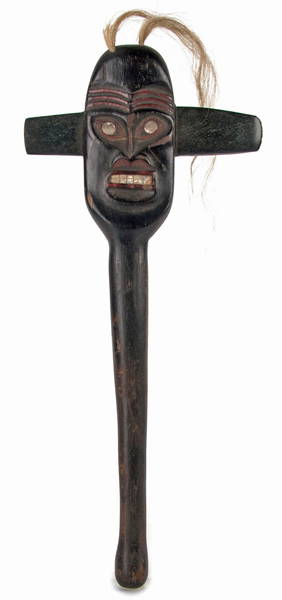
Northwest Coast Club
Club with finely carved face to top, abalone shell inlaid eyes and teeth, stone blade held in with pitch-filler. Horse hair coiffure at top. Long tubular handle with bulbous end.
Old label attached reads 'Slave killer last used 1800's by the Kwakiutls who lived around Alert Bay British Columbia.'
Height 560 mm, width 235mm
Provenance: Private collection, New Hampshire USA. Formerly in the collection of the Parker Estate, Wisconsin, USA. Californian Museum deacession number #196/1902.
Photo and text: http://www.webbs.co.nz/auction-item/superb-northwest-coast-club

Northwest Coast whalebone club, probably Haida
The club has a pierced, circular pommel, grooved grip, and expanding blade of rectangular section with seven triangular cut-outs along the lower edge, very finely carved with a killer whale, with flaring nostrils, parted lips, teeth bared, and pointed oval eye rims, additional totemic animals including a bird with recurved beak on the posterior section, the flattened upper edge decorated with a series of vertebrae; aged, creamy patina overall.
Length 25 1/2 in, 65 cm.
Photo and text: http://www.sothebys.com/

Fish Club, Tlingit: Stikine
Photo: http://www.rrnpilot.org/items/297530
Halibut fishermen used wooden clubs to kill or stun their catch; otherwise a heavy, struggling fish might turn over the canoe. The clubs were often beautifully carved, like this one which bears the image of a sea otter.
'They didn't want to spoil the head because they were going to cook it, so they were very careful where they hit it [a halibut]. / Yeah, right here in the nostrils. That stunned it and then you turned it over so the belly side was up and then it didn't fight as much. If you leave it belly side down then it bangs the boat a lot.' - Delores Churchill (Haida) / Donald Gregory (Tlingit), 2005.
Made in Fort Wrangell, Wrangell Island, Alaska, USA
Collected by George Thornton Emmons in Fort Wrangell, Wrangell Island, Alaska, USA during 1903
Identification Number: E224419-0
Length 475 mm
National Museum of Natural History
Accession number: 042081
Source: http://alaska.si.edu/record.asp?id=664
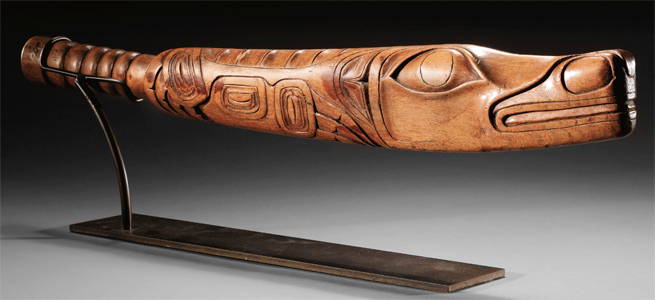
Northwest Coast wood club, probably Haida
The club has a cylindrical pommel, concentric rings on the grip, and an expanding oval head carved in the form of a swimming sea creature, probably a seal, with deeply incised backswept fins, and concentric oval motifs on the flanks, the head with flaring nostrils and pointed oval eye rims; fine aged patina overall.
Length 22 1/4 in, 565 mm
Photo and text: http://www.sothebys.com/

A Northwest Coast wood club
Carved in the form of a killer whale, the jaws parted to reveal two lines of teeth, with a raven seated behind the whale, with plain grip and pierced rounded butt, 72cm.
Inverarity (1967) shows a similar Tlingit implement, #138, and describes it as a fish club, used to kill seal, sea otter, or any large fish before hauling them into the canoe.
Photo and text: http://www.bonhams.com/auctions/14589/lot/150/

Haida polychrome wood doll
The doll is composed of a single piece of wood, finely carved in the form of a woman, standing on splayed legs, the arms held firmly at the side, the deeply hollowed head fronted by a mask, with a labret in the extended lower lip, teeth bared, flaring nostrils, and large oval eye rims beneath thick arching brows, finely painted with stylised totemic designs, the coiffure sewn and applied with spruce gum; realistically depicted breasts and genitalia beneath the printed cotton two-piece shift.
Length 19in, 48 cm.
From http://articles.boston.com/2012-07-15/travel/32635142_1_bru-jne-collectibles-wooden-doll :
An example of a local item soaring above its estimated worth was the 19th-century Haida carved wood doll from the collection of the Woburn Public Library that sold for $254 500 at Sotheby’s May auction of American Indian art. The estimate was $50 000-$70 000.
For 89 years the 19-inch doll had been kept in a glass case on the library’s third floor, its worth not recognised until earlier this year, when a Sotheby’s representative was at the library appraising two marble busts and spotted the doll.
It had been donated in 1923 by Sarah Ann Nichols, then in her 90s. She had inherited the doll from her grandfather Captain William Martain, who had purchased it in 1828 on his way home from a trading voyage to China.
Photo and text: http://www.sothebys.com/, http://articles.boston.com/2012-07-15/travel/32635142_1_bru-jne-collectibles-wooden-doll
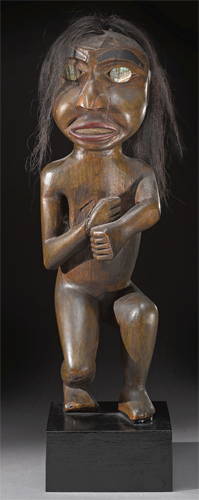
Large Northwest Coast polychrome wood figure
The figure is in a dancing posture, his exaggerated head has a compressed chin, slightly parted lips, pronounced rounded cheeks, a short hooked nose with incised nostrils, pointed oval eyes inset with abalone plaques, thick arched brows and low forehead, tufts of human hair inserted with wood plugs at the crown; fine aged patina overall with red and black painted details.
Height 23 3/4 in, 60 cm
Photo and text: http://www.sothebys.com/
Haida Carved Tobacco Pipe of Wood with Copper Bowl
Identification Number: E6014-0
The carved figures on this Haida pipe include an octopus, a horned animal, and an eagle or thunderbird holding a mask with a human face.
No Haida interpretation of this crest imagery was recorded by collector Charles S. Bulkley, who headed the Canadian section of the Western Union Telegraph project during 1865-67. Bulkley acquired the pipe during 1865 at a village in the Queen Charlotte Islands, British Columbia.
Length 215 mm
Holding Institution: National Museum of Natural History
Photo and text: http://www.rrnpilot.org/items/293367
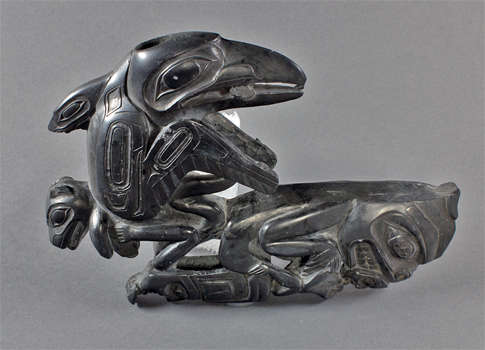
Pipe, early 19th century, unknown Haida artist, argillite.
Museum Purchase: Helen Thurston Ayer Fund, no known copyright restrictions, 43.18.2
Photo and text: http://portlandartmuseum.us/mwebcgi/mweb.exe?request=record;id=8972;type=101#
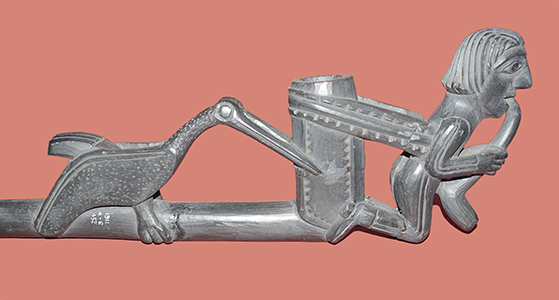
Argillite smoking-pipe, Haida (?), circa 1860s.
Height 79 mm, width 24 mm.
( This working pipe of Argillite shows a white man with what is probably a large pipe in his hands, held by a belt at his waist to the bowl of the pipe, with a long necked Sandhill Crane (?) carved behind the pipe, and split into two in a similar way to that in which images on houses were split - Don )
Catalog: Argillite, Am1911,0406.452
Photo: Don Hitchcock 2018
Source: Original, British Museum
Text: Card at Museum, http://www.britishmuseum.org/, © Trustees of the British Museum, CC BY-NC-SA 4.0
Argillite smoking-pipe, Haida, Strait of Georgia.
Height 65 mm, width 30 mm, length 263 mm.
Carved on the pipe are an eagle, a frog, and a bear. The bowl of the pipe is carved with a human face.
Catalog: Argillite, Am1929,-.16, Am1929C3.16
Photo: Don Hitchcock 2018
Source: Original, British Museum
Text: Card at Museum, http://www.britishmuseum.org/, © Trustees of the British Museum, CC BY-NC-SA 4.0
Argillite smoking-pipe with carved bird and figures, Haida, circa 1840 - 1850.
Height 50 mm, length 265 mm, width 23 mm.
The earliest argillite pipes tend to incorporate fewer figures than the later ones, which are usually more complicated, with figures separated by spaces pierced through the pipe. While the early pipes are often oval or round, and rather heavy, the later ones are longer and tend to have rectangular rather than oval cross sections. As Haida artists developed their skill in carving argillite the pipe forms became less and less functional. In particular, the pipe bowls became smaller, although both the bowl and the flue are always present.
The way in which a traditional sculptural form was altered is illustrated by the use of the extended tongue. The tongue, extending from the mouth of one creature into that of another, is a common motif on traditional artefacts and signifies the transference of spiritual power. In use on elaborate panel pipes the extended tongue became a functional method of joining together figures . This enabled the artist to cut out figures from the surrounding material, thus demonstrating his technical skill in carving a fragile stone.
Catalog: Argillite, Am,De.2, Am1882B14.2
Photo: Don Hitchcock 2018
Source: Original, British Museum
Text: Card at Museum, http://www.britishmuseum.org/, © Trustees of the British Museum, CC BY-NC-SA 4.0
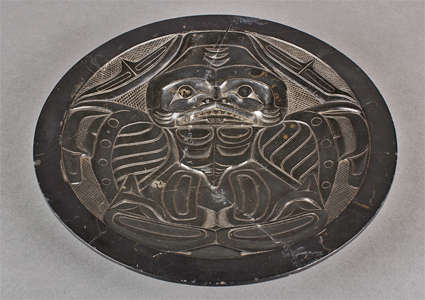
Plate, ca. 1920, unknown Haida artist, slate.
Gift of Mr. Kurt Koehler and Mrs. Schloesser, no known copyright restrictions, 44.13
Photo and text: http://portlandartmuseum.us/mwebcgi/mweb.exe?request=record;id=9091;type=101#
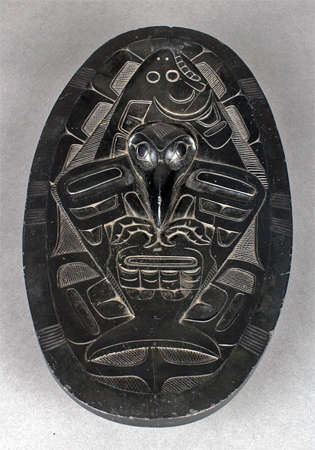
Platter, ca. 1900, unknown Haida artist, argillite.
( this platter displays a raven superimposed on a halibut - Don )
The Elizabeth Cole Butler Collection, no known copyright restrictions, 87.88.60
Photo and text: http://portlandartmuseum.us/mwebcgi/mweb.exe?request=record;id=25535;type=101#
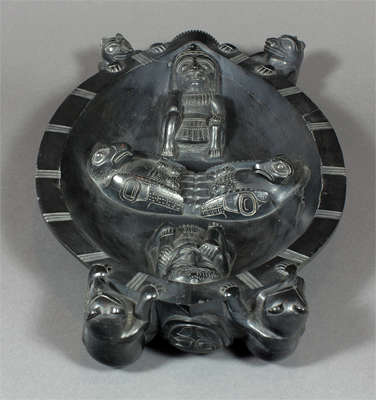
Platter, ca 1900, unknown Haida artist, argillite.
(The artistry and workmanship of this piece in particular is staggering. Only a 'rich' culture, one with a great abundance of food and other resources could possibly support the specialist artists and artisans needed to complete work of this standard - Don )
Museum Purchase: Indian Collection Subscription Fund, Rasmussen Collection of Northwest Coast Indian Art, no known copyright restrictions, 48.3.680
Photo and text: http://portlandartmuseum.us/mwebcgi/mweb.exe?request=record;id=10326;type=101#
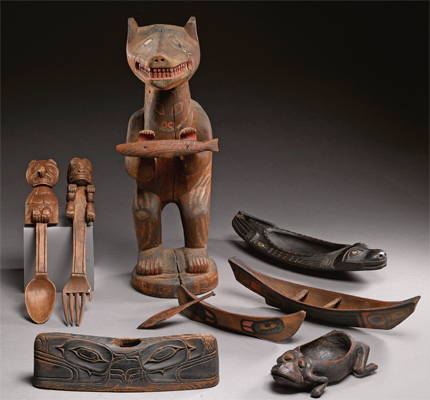
Group of Northwest Coast wooden objects
This group comprises a bear holding a fish, a seal dish with bead and abalone inlay, a frog dish, a hollow, boat-shaped vessel finely carved on the exterior with form line decoration, possibly a weaving implement, a hawk-effigy spoon, a bear-effigy fork, and two model canoes, one with a paddle, both painted with totemic designs.
height of bear 24 in, 61 cm, length of dishes 17 1/2 in, 44.5 cm, and 8 1/2 in, 21.5 cm, implement 13 1/4 in, 33.5 cm, spoon and fork 15 1/2 in, 39.5 cm each; canoes 17 1/2 in, 44.5 cm, and 12in, 30.5 cm.
Photo and text: http://www.sothebys.com/
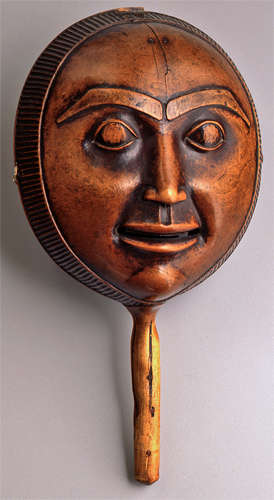
Rattle, ca. 1850, unknown Haida artist, maple wood and leather.
Acquired from Exchange and receipts from sale of Indian Collection surplus, no known copyright restrictions, 55.256
Source: http://portlandartmuseum.us/mwebcgi/mweb.exe?request=record;id=11533;type=101#
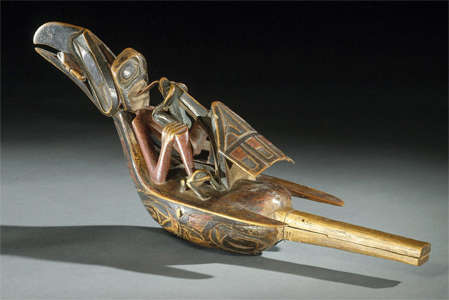
Raven Rattle
Said to originate in the north, perhaps among the Tsimshian, the raven rattle is now considered an item of traditional regalia throughout the Northwest Coast. Chiefs use these rattles as part of their ceremonial dress in dances. This rattle depicts a shaman on the back of a raven. The raven has a frog in its mouth, another frog touches the shaman's tongue, and frogs are on the feet. The bottom also has a raven carved with abstracted figures.
All these representations are transformative animals that relate to the legendary stories of the tribe, and the sound of rattles forms a conduit to the supernatural world when the rattles are employed by shamans. The use of the raven rattle always implies power. For example, it is used in dances that demonstrate the status of the chief, who has a hereditary right to use it.
Rights Statement: Creative Commons-BY
Brooklyn Museum photograph
Source: http://www.brooklynmuseum.org/opencollection/objects/132835/Raven_Rattle/
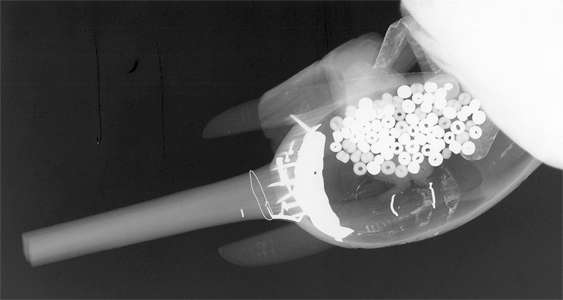
This is an xray of the Raven Rattle above, showing the beads inside that make the characteristic noise of the rattle when shaken.
Culture: Tsimshian, Native American
Medium: Wood, pigment, rattles, cotton twine
Place collected: Bella Bella, British Columbia, Canada
Date: 19th century
Dimensions: 5 1/2 x 14 x 4 in. (140 x 356 x 102 mm)
Accession Number: 05.588.7292
Credit Line: Museum Expedition 1905, Museum Collection Fund
Rights Statement: Creative Commons-BY
Brooklyn Museum photograph
Source: http://www.brooklynmuseum.org/opencollection/objects/132835/Raven_Rattle/
How Raven Stole the Sun
According to a Haida story, in the beginning the world was in total darkness. The Raven, who had existed from the beginning of time, was tired of groping about and bumping into things in the dark.Eventually the Raven came upon the home of an old man who lived alone with his daughter. Through his slyness, the Raven learned that the old man had a great treasure. This was all the light in the universe, contained in a tiny box concealed within many boxes. At once the Raven vowed to steal the light.
He thought and thought, and finally came up with a plan. He waited until the old man's daughter came to the river to gather water. Then the Raven changed himself into a single hemlock needle and dropped himself into the river, just as the girl was dipping her water-basket into the river. As she drank from the basket, she swallowed the needle. It slipped and slithered down into her warm belly, where the Raven transformed himself again, this time into a tiny human. After sleeping and growing there for a very long time, at last the Raven emerged into the world once more, this time as a human infant.
Even though he had a rather strange appearance, the Raven's grandfather loved him. But the old man threatened dire punishment if he ever touched the precious treasure box. Nonetheless the Raven child begged and begged to be allowed to hold the light just for a moment. In time the old man yielded, and lifted from the box a warm and glowing sphere, which he threw to his grandson.
As the light was moving toward him, the human child transformed into a gigantic black shadowy bird-form, wings spread ready for flight, and beak open in anticipation. As the beautiful ball of light reached him, the Raven captured it in his beak! Moving his powerful wings, he burst through the smokehole in the roof of the house, and escaped into the darkness with his stolen treasure.
And that is how light came into the universe.
(This is the simplest yet best told version of this legend that I have read. It comes from: http://www.magma.ca/~jbremner/blog/months/RavenStealsSun.htm - Don )
Ceremonial rattle depicting the legend of Ka-ka-tele, the whistling demon
The catalogue card states, ' A ceremonial rattle of magical powers, with painted carving in relief, depicting the legend of Ka-ka-tele, the whistling demon.'
This description refers to a raven rattle. The tip of the raven' s beak is slightly broken, but it is holding a small red block - the sun according to myths. Lying on the raven' s back is a red humanoid figure which has its hands on its knees and legs spread. The humanoid figure shares a tongue with a long thin beaked bird. The bird could be a kingfisher as it has a four feather plumage extending from the rear of its head.
The belly of the raven is expertly carved and painted with elaborate U-forms and ovoids which form a hook nosed creature, possibly a hawk, but highly ambiguous. The tips of the raven' s wings extend towards the back of the rattle, and the handle is wrapped with cherry bark.
The style of this rattle suggests it is Tlingit in origin (Dr Gillian Crowther, Professor of Anthropology, Capilano University, Vancouver BC). The raven rattles are known to have been chiefs dancing rattles, and were held what we would consider to be upside down, with the raven on the underneath, in order to prevent the bird from taking flight.
The meaning of the projecting tongue linking the humanoid and the bird has long fascinated anthropologists, with interpretations concentrating on sexual imagery and the transference of power. However it cannot be accurately stated what the true meaning is, indeed it may be intentionally open to many meanings.
Exhibited: Old Anthropological displays at CUMAA, case 21 and 22, dismantled 081986. New Anthropological displays, square case, 1990-.
Made in British Columbia, Canada
Identification Number: E 1903.57
Acquisition Date: during 1903
Photo and text: http://www.rrnpilot.org/items/160286

Northwest Coast polychrome wood ceremonial rattle, probably Tlingit
The rattle is of classic form, in two sections, with twine on the cylindrical grip, a birdlike face with hooked beak and form line details on the underbelly, the body in the form of a flying raven, holding a disk, probably a representation of the sun, in its slightly parted beak, its flattened backswept wings supporting a reclining shaman, with angular body and limbs, hands resting on his abdomen, and mask-like face, confronting another bird, with short backswept feather crest holding a frog in its long, narrow beak, the details finely incised and carved in shallow and sunk relief, a fine aged patina overall; Native repair in the form of a hide panel pegged to the back of the crest.
Length 12 7/8 in, 32.5 cm.
Photo and text: http://www.sothebys.com/
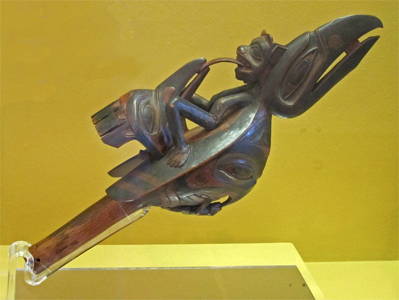
Chief's Dancing Rattle
Mid 19th century, Queen Charlotte Island, British Columbia, Canada
Haida
Wood
Photo: Haa900, 2010
Permission: Public Domain
Source: Honolulu Academy of Arts
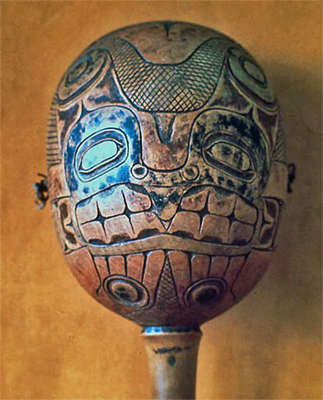
Rattle
Gitxsan engraved shaman's globular rattle. CMC collection.
Language group: Tsimshian
Sub-language group: Gitxsan
Village: Ksan Historical Village
Photo: © G.F. MacDonald
Permission: Courtesy George MacDonald, Director, Bill Reid Centre for NWC Art Studies at Simon Fraser University, Vancouver, BC.
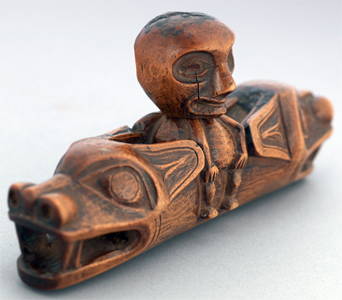
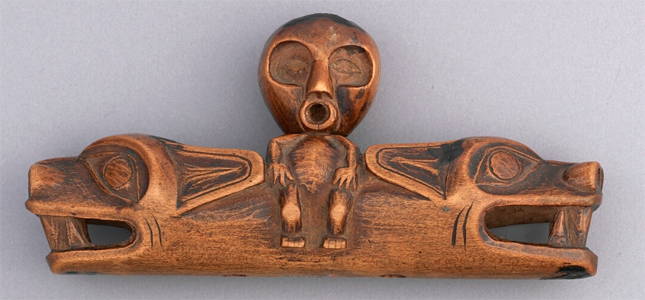
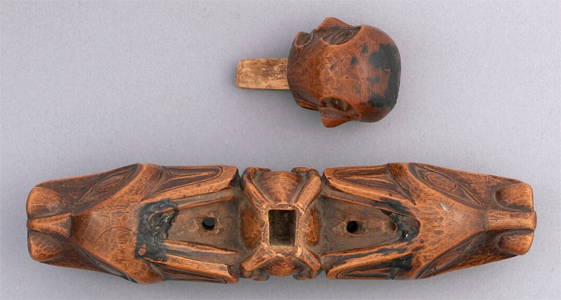
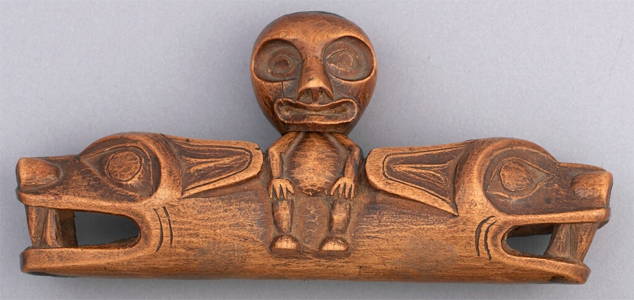
Northwest Coast Soul Catcher
A1774 a-b
Culture: Haisla
Soul catcher carved from wood in two parts:
a) two carved Sisiutl heads facing outwards with a humanoid body seated at the centre;
b) a humanoid head with a peg that fits into a shaft in part a.
Sisiutl is the god of warrior invincibility, a magic war-canoe that can go underground (Winalagalis), and guardian of the house of the sky people.
Carried by a shaman when he pursued the soul of an ailing patient under his care. usually at twilight. The soul fluttered toward the horizon. With the stopper removed from his magic box, the shaman followed it, beguiling it with incantations. When he succeeded in approaching it, he popped it into the box, replaced the stopper, and returned it to the patient, who then recovered.
Made in Kitlope, British Columbia, Canada before 1914
Collected between 1893 and 1934
Owned by George Henry Raley before November 1948
Received from H. R. MacMillan (Funding source) and George Henry Raley (Seller) during November 1948
Identification Number: A1774 a-b
Height 76 mm, width 165 mm, depth 38 mm
Condition: good
Current location: Case 021
Accession number: 1960/182 a-b
Photo and text: http://www.rrnpilot.org/items/34642
Additional text: Wikipedia
Lax Aak - Soul Catcher
A2476
Culture: Gitxsan ?
Hollow tubular bone, somewhat flared at two open ends, which are cut to represent the open mouth of an animal. Eyes are carved above each mouth; incised designs indicate nostrils and gills. Two small holes at centre top of tube.
The oral tradition states that a soul catcher was made from the shin bone (femur) of a grizzly bear. It was worn suspended around the neck and used by the Halayt (shaman) to capture and return souls that had left the body, thus causing illness. Originally cedar bark plugs were used in the openings at either end to contain the spirits or souls, that had been captured to return to a host.
Made in British Columbia, Canada
Received from Walter C. Koerner (Donor) on April 8, 1976
Material: bear bone ?
Height 22 mm, width 212 mm, depth 39 mm
Condition: good
Current location: Case 019
Accession number: 336/66
Photo: Don Hitchcock 2012
text: http://www.rrnpilot.org/items/11698
Source: Display, Museum of Anthropology, University of British Columbia
Lax Aak - Soul Catcher
Identification Number: 1100/1
Culture: Gitxsan
Soul catcher made of a tubular piece of bone with inlaid abalone. Overall shape is of two open-mouthed animal heads facing outward, toward the ends. Abalone shell is inlaid on one side of the faces at teeth, eyes, cheeks, ears, and nostrils.
The oral tradition states that a soul catcher was made from the shin bone (femur) of a grizzly bear. It was worn suspended around the neck and used by the Halayt (shaman) to capture and return souls that had left the body, thus causing illness. Originally cedar bark plugs were used in the openings at either end to contain the spirits or souls, that had been captured to return to a host.
Made in British Columbia, Canada during 1850
Received from Marjorie J. Finlayson (Donor) on January 31, 1986
Material: bear bone ? and abalone shell
Height 24 mm, width 187 mm, depth 39 mm
Current location: Case 019
Photo and text: http://www.rrnpilot.org/items/32165
Source: Display, Museum of Anthropology, University of British Columbia
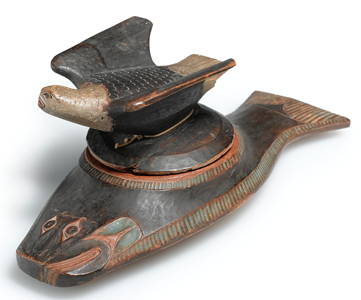
Tsimshian polychrome wood lidded dish
Dish in the form of a halibut, the head with a pair of oval eye rims enclosing pierced pupils, the periphery and tail finely incised with a linear design, the body centring a deep circular bowl, inset with a lid surmounted by a bald eagle, with splayed wings and tailfeathers; the whole painted in red, green, black and white pigments.
Length 12 3/4 in, 32.5 cm, by height with lid 4 7/8 in, 12.5 cm, by width 5 1/2 in, 14 cm.
Photo and text: http://www.sothebys.com/
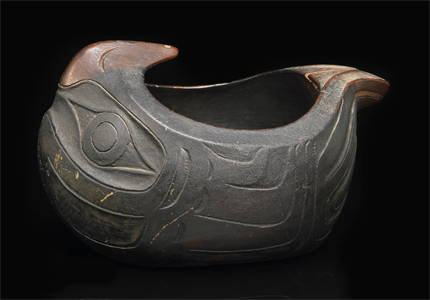
A Haida or Tlingit eagle effigy bowl
An oval utensil conceived as a stylised eagle, the raptor's head rising at front with its beak curving over the interior cavity, similarly the upswept tail feathers project as a parallel focal point. The sides show wings and lined images in shallow relief, such images at the back clearly evoking another avian face when seen upside down - an apparent visual pun. The bowl has a rich dark and oily patina from use.
Height 108 mm, length 180 mm
Photo and text: http://m.bonhams.com/auctions/18132/lot/1146/
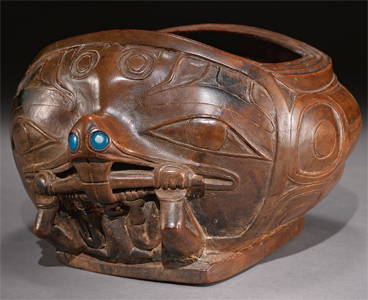
Tlingit wood effigy bowl
Bowl with flat base and bulging sides, a beaver on the front end, with protruding snout inset with blue glass beads, wide-set pointed oval eye rims beneath arched brows and conventionalised ears, a stick held in its front paws, surmounting a compact human figure, the sides with form line elements carved in relief, probably representations of the back legs and feet, the opposite end decorated with a bird, probably a raven, with straight beak, and a sculpted human or spirit face emerging from between its ears.
Length 10 3/4 in, 27.5 cm by width 9 1/2 in, 24 cm.
Photo and text: http://www.sothebys.com/
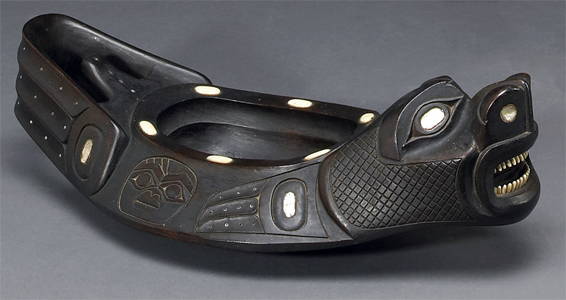 Tlingit seal effigy bowl
Tlingit seal effigy bowl
Carved by Augustus Bean and Rudolf Walton
The head and rear flippers are in bold relief, with inset abalone eyes, ivory teeth and white bead accents, front flippers and totemic faces incised about the sides, the bowl cavity ringed with oval ivory inserts. Length 394 mm
Augustus Bean (see photograph below) and Rudolf Walton were Tlingit carvers who trained at the Sheldon Jackson School (later Museum) in the later nineteenth century and subsequently ran a shop in Sitka, Alaska. Their work is held in high regard.
Similar to the Carlisle Indian School, Sheldon Jackson College (SJC) was initially formed as a 'training' school for Alaska Native boys. The school was founded in 1878 by Fannie Kellogg and the future Governor of Alaska John G. Brady for the Tlingit people. Initially known as the Sitka Industrial and Training School, it nearly closed in 1882 after its original facility, located over a military barracks, burned down. The Presbyterian missionary Sheldon Jackson came to the rescue of the school, raising funds through a national campaign, leading to the construction of a new building on the site of the present campus. In 1910, after Rev. Jackson died, the school was renamed in his honour.
Photo and text: http://m.bonhams.com/auctions/18132/lot/1146/
Additional text on the Sheldon Jackson College from Wikipedia
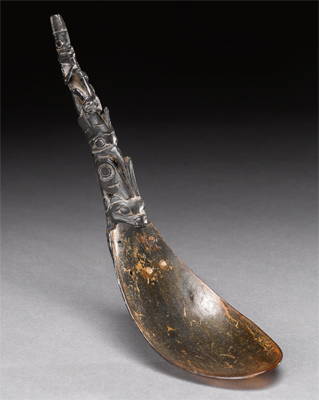
Northwest Coast goat horn spoon
A spoon of classic form, with a shallow translucent bowl, Native copper pins, and tapering handle finely carved with a beaver, its hatched tail on the reverse, surmounted in turn by two totemic creatures and a shaman.
Length 8 3/4 in, 22 cm.
Photo and text: http://www.sothebys.com/
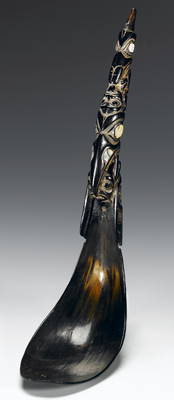
Northwest Coast Mountain Goat Horn Spoon
Composed of two sections, the tip of the handle carved with a raven with anthropomorphic body, an inverted human head with tongue extended between the bird's beak, followed by a larger raven, his beak curled around a human head, the wings extended to either side of the oval bowl.
The handle has abalone shell inlays and is secured to the bowl with a single copper pin, the underside of the bowl with an old collection label inscribed: 'Indian Spoon Naas River?…'
Photo and text: http://www.bonhams.com/auctions/14589/lot/119/

Unknown Haida artist, ladle, ca. 1900, mountain goat horn and abalone shell.
The Elizabeth Cole Butler Collection, no known copyright restrictions, 2013.1.7
Photo and text: http://portlandartmuseum.us/mwebcgi/mweb.exe?request=record;id=33595;type=101#
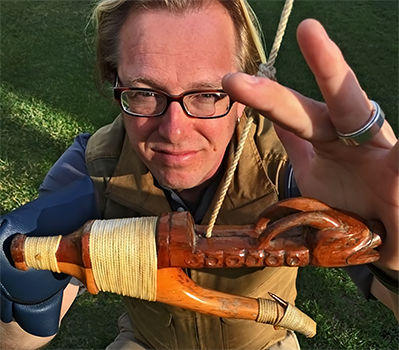
Jonathan Malidine displays a halibut hook made by Jon Rowan, a Tlingit master carver. The hook has caught fish; note the scratches from teeth on the lower arm.
The Tlingit and Haida, indigenous peoples of the Northwest Coast (NWC), have used carved wooden hooks to catch halibut for centuries. As modern fishing technology crept into use, however, the old hooks practically disappeared from the sea. But they thrived on land - as decorative art.
The hook's evolution from utilitarian tool to expression of cultural heritage is the subject of a paper by Jonathan Malindine, a doctoral student in UC Santa Barbara's Department of Anthropology. In 'Northwest Coast Halibut Hooks: an Evolving Tradition of Form, Function, and Fishing', published in the journal Human Ecology, he traces the arc of the hook's design and how its dimensions have changed over time.
'I used to be a commercial fisherman in Alaska, and also lived in a Tlingit and Haida community', Malindine said. 'So, the intersection of fisheries and Alaska Native art has always fascinated me. These NWC hooks are really effective at catching halibut, and also are intricately carved with rich, figural designs. Between the technology and the mythological imagery, there's a lot going on.'
Halibut hooks, often called wood hooks, are part of a sophisticated apparatus for catching the flat, bottom-dwelling fish that can weigh more than 500 pounds. Constructed in two pieces of different woods, they look something like an open fish mouth from the side, with a barb, facing backwards, lashed to the top piece. When the fish tries to spit out the hook, the barb sets in its jaw. Hooks were carefully carved to maximise their potential for catching fish, and their shape and size varied depending on the size of halibut they were used for.
Photo: University of California - Santa Barbara
Text: https://phys.org/news/2017-02-team-evolution-wooden-halibut-native.html
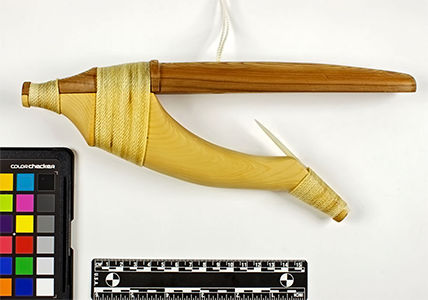
But as modern fishing technology displaced traditional gear, wood hooks began to change, varying greatly in design and dimension from early versions. These "art hooks" were created as decorative objects, often depicting animals important to NWC traditions and using materials such as abalone inlay.
It was that transition in the hooks, from utility to art, that Malindine studied. To do so, he examined, photographed and took detailed measurements of every intact NWC hook - 109 total - in the collections of the National Museum of Natural History and the National Museum of the American Indian. He found that 'in the case of NWC halibut hooks, shifting function drives the shift in materials, dimension, and meaning', he writes in the paper. 'The NWC halibut hook has largely ceased to function to catch fish, and its dimensions are changing to favor decorative and symbolic content over utilitarian/functional requirements. Nowadays it is primarily designed to link Alaska Natives to their ancestral heritage, and the art buyer to a tangible representation of NWC mythological and artistic tradition.'
Photo: Jonathan Malindine
Text: https://phys.org/news/2017-02-team-evolution-wooden-halibut-native.html
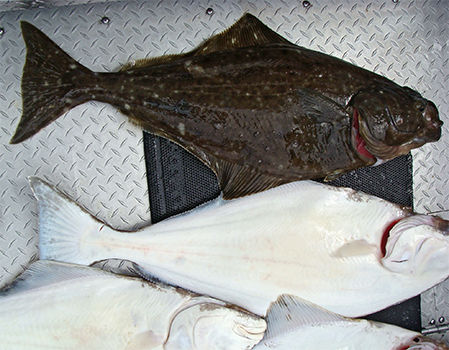
Pacific Halibut taken in Cook's Inlet, Alaska. Halibut tend to be a mottled dark brown on their upward-facing side and white on their downside
Pacific halibut, Hippoglossus stenolepis, are the largest flatfish in the world, weighing as much as 300 kilograms and reaching 2.7 metres in length. The Canadian portion of the West Coast Pacific halibut fishery occurs along the entire coast of British Columbia. The resource is jointly managed by the governments of the United States and Canada through the International Pacific Halibut Commission.
Photo: Jlikes2Fish
Permission: Public Domain
Text: http://www.dfo-mpo.gc.ca/fm-gp/sustainable-durable/fisheries-peches/halibut-fletan-eng.htm, Wikipedia
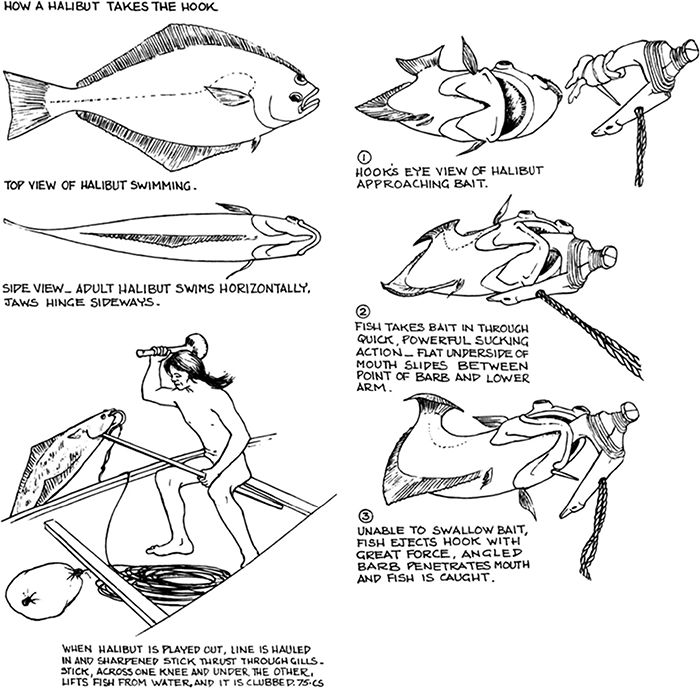
How a halibut takes the hook.
Photo and text: Stewart (2008)
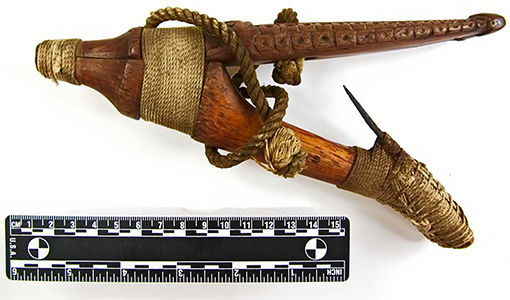
In addition to its contributions to academia, the research will benefit NWC carvers of wood hooks. Malindine has shared his work with them, allowing them to see what the hooks looked like as many as 150 years ago. 'The Alaska Native carvers and Tribal members with whom I've shared these images and dimensional measurements are just happy to see them', he said. 'These hooks are part of their cultural heritage, and have basically been locked away in storage facilities—sometimes for a hundred years.'
Photo: Jonathan Malindine
Text: https://phys.org/news/2017-02-team-evolution-wooden-halibut-native.html
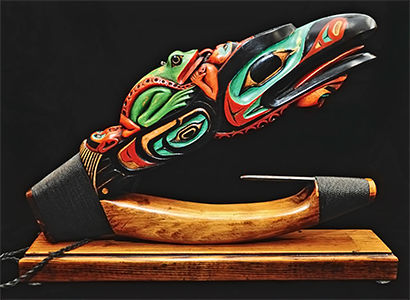
As Malindine noted, wood hooks are still more than curiosities or museum pieces. 'I was fortunate enough to interview two of the very few people who still fish with traditional wood hooks', he said. 'One of them, Jon Rowan, claims he has as much, if not more, success using wood hooks to catch halibut than he does using modern fishing gear. These have stuck around for a reason: They're very good at catching halibut. Of course most people don't want to risk losing a valuable and beautiful carved NWC halibut hook, so almost everyone these days uses commercially produced circle hooks that cost a few dollars each.'
Photo: Jonathan Malindine
Text: https://phys.org/news/2017-02-team-evolution-wooden-halibut-native.html

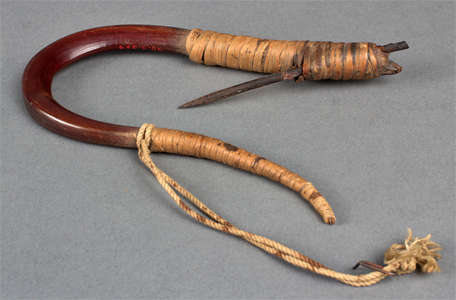
Fish Hook, Haida artist.
Pre-contact, yew wood and string
Museum Purchase: Indian Collection Subscription Fund, Rasmussen Collection of Northwest Coast Indian Art, no known copyright restrictions, 48.3.304
Photo and text: http://portlandartmuseum.us/mwebcgi/mweb.exe?request=record;id=9911;type=101#
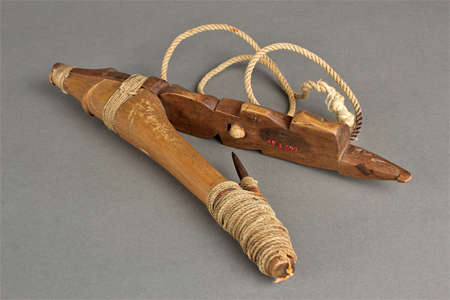
Fish Hook, Haida artist.
Ca 1900, wood.
Museum Purchase: Indian Collection Subscription Fund, Rasmussen Collection of Northwest Coast Indian Art, no known copyright restrictions, 48.3.693
Photo and text: http://portlandartmuseum.us/mwebcgi/mweb.exe?request=record;id=10340;type=101#
References
- Inverarity, R., 1967: Art of the Northwest Coast Indians, Second Edition, University of California Press, 01/08/1967
- Malindine, J., 2017: Northwest Coast Halibut Hooks: an Evolving Tradition of Form, Function, and Fishing, Human Ecology, 2017, DOI: 10.1007/s10745-016-9884-z
- Mayer, C., Shelton A., 2010: The Museum of Anthropology at the University of British Columbia, University of Washington Press, February 15, 2010
- Samuel, C., 1990: The Chilkat Dancing Blanket, University of Oklahoma Press, September 15, 1990
- Stewart, H., 2008: Indian Fishing: Early Methods on the Northwest Coast, Douglas & McIntyre Publishers, 1 Sep. 2008 - Social Science - 181 pages
Back to Don's Maps
 Back to Archaeological Sites
Back to Archaeological Sites
 Back to Pacific NW Coast index
Back to Pacific NW Coast index

